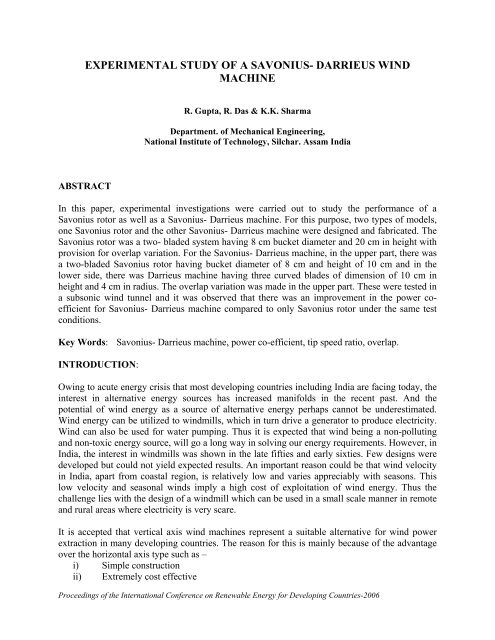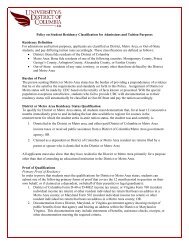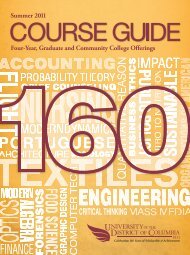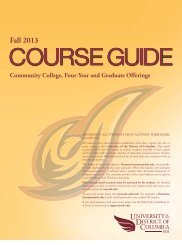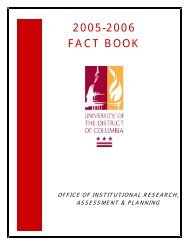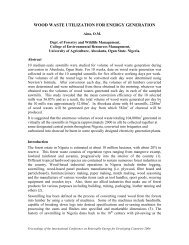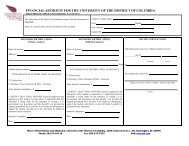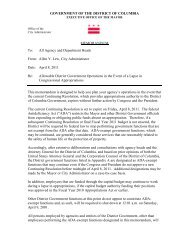Experimental study of a savonius- darrieus wind - Wrapwind.com
Experimental study of a savonius- darrieus wind - Wrapwind.com
Experimental study of a savonius- darrieus wind - Wrapwind.com
Create successful ePaper yourself
Turn your PDF publications into a flip-book with our unique Google optimized e-Paper software.
EXPERIMENTAL STUDY OF A SAVONIUS- DARRIEUS WIND<br />
MACHINE<br />
R. Gupta, R. Das & K.K. Sharma<br />
Department. <strong>of</strong> Mechanical Engineering,<br />
National Institute <strong>of</strong> Technology, Silchar. Assam India<br />
ABSTRACT<br />
In this paper, experimental investigations were carried out to <strong>study</strong> the performance <strong>of</strong> a<br />
Savonius rotor as well as a Savonius- Darrieus machine. For this purpose, two types <strong>of</strong> models,<br />
one Savonius rotor and the other Savonius- Darrieus machine were designed and fabricated. The<br />
Savonius rotor was a two- bladed system having 8 cm bucket diameter and 20 cm in height with<br />
provision for overlap variation. For the Savonius- Darrieus machine, in the upper part, there was<br />
a two-bladed Savonius rotor having bucket diameter <strong>of</strong> 8 cm and height <strong>of</strong> 10 cm and in the<br />
lower side, there was Darrieus machine having three curved blades <strong>of</strong> dimension <strong>of</strong> 10 cm in<br />
height and 4 cm in radius. The overlap variation was made in the upper part. These were tested in<br />
a subsonic <strong>wind</strong> tunnel and it was observed that there was an improvement in the power coefficient<br />
for Savonius- Darrieus machine <strong>com</strong>pared to only Savonius rotor under the same test<br />
conditions.<br />
Key Words: Savonius- Darrieus machine, power co-efficient, tip speed ratio, overlap.<br />
INTRODUCTION:<br />
Owing to acute energy crisis that most developing countries including India are facing today, the<br />
interest in alternative energy sources has increased manifolds in the recent past. And the<br />
potential <strong>of</strong> <strong>wind</strong> energy as a source <strong>of</strong> alternative energy perhaps cannot be underestimated.<br />
Wind energy can be utilized to <strong>wind</strong>mills, which in turn drive a generator to produce electricity.<br />
Wind can also be used for water pumping. Thus it is expected that <strong>wind</strong> being a non-polluting<br />
and non-toxic energy source, will go a long way in solving our energy requirements. However, in<br />
India, the interest in <strong>wind</strong>mills was shown in the late fifties and early sixties. Few designs were<br />
developed but could not yield expected results. An important reason could be that <strong>wind</strong> velocity<br />
in India, apart from coastal region, is relatively low and varies appreciably with seasons. This<br />
low velocity and seasonal <strong>wind</strong>s imply a high cost <strong>of</strong> exploitation <strong>of</strong> <strong>wind</strong> energy. Thus the<br />
challenge lies with the design <strong>of</strong> a <strong>wind</strong>mill which can be used in a small scale manner in remote<br />
and rural areas where electricity is very scare.<br />
It is accepted that vertical axis <strong>wind</strong> machines represent a suitable alternative for <strong>wind</strong> power<br />
extraction in many developing countries. The reason for this is mainly because <strong>of</strong> the advantage<br />
over the horizontal axis type such as –<br />
i) Simple construction<br />
ii) Extremely cost effective<br />
Proceedings <strong>of</strong> the International Conference on Renewable Energy for Developing Countries-2006
iii)<br />
Acceptance <strong>of</strong> <strong>wind</strong> flow from any direction without orientation.<br />
In spite <strong>of</strong> these advantages vertical axis turbine is not gaining popularity because <strong>of</strong> low<br />
efficiency <strong>of</strong> the Savonius type rotor and low starting torque <strong>of</strong> the Darrieus type <strong>wind</strong> machines.<br />
From the literature, it is observed that scientists largely deal with Savonius or Darrieus<br />
individually [1-5]. There are few works that analyze the <strong>com</strong>bined Savonius- Darrieus<br />
configuration [6].<br />
The vertical axis Savonius rotor was initially developed by S.J. Savonius in late twenties<br />
[7]. The concept <strong>of</strong> Savonius rotor was based on the principle developed by Flettner. Savonius<br />
used a rotor , which was formed by cutting a cylinder into two halves along the central plane and<br />
then moving to two semi- cylindrical surfaces sideways along the cutting plane, that the crosssection<br />
resembled the letter `S`. An optimum geometry was obtained by systematically testing<br />
more than 30 different models in a <strong>wind</strong> tunnel and Savonius reported encouraging results. He<br />
conducted further tests in natural <strong>wind</strong> and observed that rotor run at a higher speed than that in<br />
the <strong>wind</strong> tunnel for the same <strong>wind</strong> velocity. According to Savonius, the best <strong>of</strong> his rotor had a<br />
maximum efficiency <strong>of</strong> 31% while the maximum efficiency <strong>of</strong> the prototype was 37%.<br />
Following Savonius, Newman, Sivasegaram and Khan[8-10] among others conducted several<br />
experiments to investigate the effect <strong>of</strong> geometrical parameters such as blade gap size, overlap<br />
etc.<br />
Darrieus type rotors are lift devices, characterized by curved blades with an air-foil crosssection.<br />
They have relatively low starting torque and high power output per given rotor weight.<br />
The Darrieus type machine was invented and patented in 1925 by G.J. Darrieus, a French<br />
Engineer. Darrieus machine has two or three thin curved blades with air-foil cross-section and<br />
constant chord length. Both ends <strong>of</strong> the blades are attached to a vertical shaft. When rotating,<br />
these air-foil blades provide a torque about the central shaft in response to a <strong>wind</strong> stream.<br />
Based on the literature review, it has been decided to design and fabricate Savonius rotor<br />
as well as Savonius- Darrieus machine and to experimentally investigate their performances. The<br />
purpose <strong>of</strong> the present <strong>study</strong> is to investigate the performance <strong>of</strong> Savonius- Darrieus machine and<br />
to <strong>com</strong>pare its performance with the Savonius rotor under the same test conditions.<br />
WIND DATA AT NATIONAL INSTITUTE OF TECHNOLOGY SILCHAR<br />
To know the <strong>wind</strong> conditions, <strong>wind</strong> data were collected at National Institute <strong>of</strong><br />
Technology, Silchar, which is situated in southern part <strong>of</strong> Assam, a backward place <strong>of</strong> North-<br />
Eastern region <strong>of</strong> India. Wind data were collected with the help <strong>of</strong> a cup type anemometer. Data<br />
were recorded for the last three years and from the data it is observed that <strong>wind</strong> velocity is quite<br />
low and a sample data has been shown in Fig.1.<br />
Proceedings <strong>of</strong> the International Conference on Renewable Energy for Developing Countries-2006
Fig.1. WIND DATA FOR THE MONTH OF APRIL 2003<br />
THE WIND TUNNEL<br />
A brief description <strong>of</strong> the <strong>wind</strong> tunnel is given below: (Fig:2)<br />
a) Blower section- The blower section <strong>of</strong> an axis flow fan having variable pitch blades in a<br />
cylindrical casing. The capacity <strong>of</strong> the fan is 6700 cu ft/min at 2890 rpm. The fan is driven by<br />
a three phase 15 kW motor.<br />
b) Honey<strong>com</strong>b Chamber- The honey<strong>com</strong>b chamber is at the entrance <strong>of</strong> the tunnel to break the<br />
large scale disturbances and eddies. It <strong>com</strong>prises a number <strong>of</strong> strawboard placed side by side<br />
and their axis parallel with the direction <strong>of</strong> flow or the axis <strong>of</strong> the tunnel.<br />
c) Settling chamber- The frictional resistance <strong>of</strong> the flow is increased by the honey<strong>com</strong>b, so<br />
improving the distribution <strong>of</strong> longitudinal velocity .But the wakes <strong>of</strong> the honey<strong>com</strong>b tubes<br />
introduced relatively minor disturbances and turbulence into the flow. A settling length <strong>of</strong><br />
chamber is therefore required downstream after honey<strong>com</strong>b is therefore required downstream<br />
after honey<strong>com</strong>b chamber.<br />
d) Wire mesh or damping screen- Two damping screens <strong>of</strong> stainless wire netting are placed in<br />
the low velocity region up <strong>of</strong> contraction cone. These remove the large scale eddies, but<br />
produce smaller eddies that decay rapidly.<br />
e) Settling Chamber- Just after the damping screen there is another chamber which allows the<br />
eddies to decay further.<br />
Proceedings <strong>of</strong> the International Conference on Renewable Energy for Developing Countries-2006
f) Contraction zone-The contraction cone (or entrance cone) produces a uniform velocity<br />
distribution with weak turbulence in the test section, but with a minimum <strong>of</strong> energy loss.<br />
g) Test Section-The test section has four plates, two <strong>of</strong> which are made <strong>of</strong> glass .There are holes<br />
in the upper horizontal plate made <strong>of</strong> wood for inserting a static tube. One <strong>of</strong> the vertical<br />
glass plates can be opened for inserting the work piece sample to be `tested ‘. The four plates<br />
make square section <strong>of</strong> dimension 300mm* 300mm. The length <strong>of</strong> the test section is 3<br />
meters.<br />
h) Exit valve-At the exit, a value controls the air velocity in the test section.<br />
SCREENS<br />
CONTRACTION CONE<br />
DIFFUS<br />
ER<br />
100<br />
100<br />
300<br />
BLOWER<br />
SETTLING CHAMBER<br />
TEST SECTION<br />
MODEL<br />
175<br />
VALVE<br />
60<br />
(all dimensions are in m.m)<br />
Fig 2: WIND TUNNEL.<br />
MODEL TESTS<br />
Two types <strong>of</strong> models, one simple Savonius rotor and the other Savonius-Darrieus machines were<br />
designed and fabricated. The simple Savonius was a two-bladed system having 8 cm bucket dia<br />
& 20 cm in height with provision for overlap variation [fig 3]. For the Savonius- Darrieus type <strong>of</strong><br />
machine, in the upper part, a two bladed S-rotor having bucket diameter <strong>of</strong> 8 cm and height <strong>of</strong> 10<br />
cm, whereas in the lower side <strong>of</strong> Darrieus machine having three curved blades <strong>of</strong> dimensions <strong>of</strong><br />
10 cm in height and 4 cm in radius[fig. 4]. There was also a provision for variation <strong>of</strong> overlap in<br />
the upper part <strong>of</strong> the Savonius- Darrieus machine. The material used for both the cases was<br />
aluminum. The experiments were carried out in a low speed open circuit <strong>wind</strong> tunnel which<br />
provide an air velocity adjustable between 0 and 30 m/sec. Tests were conducted for S-rotor with<br />
and without overlap and Savonius- Darrieus machine with and without overlap. The overlap<br />
variation was 16.2 % & 20% for both the cases.. The rotor speed was measured using a digital<br />
tachometer having a least count <strong>of</strong> 1 rpm and the <strong>wind</strong> velocity was determined using the Pitot<br />
static tube.<br />
Proceedings <strong>of</strong> the International Conference on Renewable Energy for Developing Countries-2006
ANALYSIS & CONCLUSION:<br />
The purpose <strong>of</strong> the present <strong>study</strong> is to investigate the performance <strong>of</strong> the Savonius-<br />
Darrieus <strong>wind</strong> machine and <strong>com</strong>pare its performance with the simple S-rotor. The performance<br />
<strong>of</strong> the machine can be expressed in the form <strong>of</strong> Power Coefficient (Cp) versus tip-speed ratio (λ).<br />
For analysis, the following relations were used:-<br />
i) Co-efficient <strong>of</strong> Performance Cp = P rotor<br />
0.5ρV 2<br />
ii) Tip speed ratio (λ) = Velocity <strong>of</strong> blade tip<br />
Free stream velocity<br />
Graphs between Cp versus TSR for S-rotor without overlap has been plotted in [fig 5]. Figs 6 &<br />
7 show the plot between Cp versus TSR for S-rotor with 16.2% and 20 % overlap respectively.<br />
Graph between Cp versus TSR for Savonius- Darrieus <strong>wind</strong> machine has been plotted in fig. 8.<br />
Figures 9 & 10 show the graphs between Cp versus TSR for Savonius- Darrieus <strong>wind</strong> machine<br />
with 16.2% and 20% overlap respectively.<br />
From figure 5, it is observed that Cp increases with increase <strong>of</strong> TSR but up to a certain<br />
limit. After that Cp decreases even with the increase <strong>of</strong> TSR. The maximum Cp obtained is 16 %<br />
at about 0.18 TSR. From the fig 6, it is observed that with 16.2 % overlap, there is slight<br />
improvement <strong>of</strong> Cp although the trend <strong>of</strong> variation <strong>of</strong> Cp with TSR is similar to that <strong>of</strong> S-rotor<br />
without overlap. The maximum Cp observed here is 18% at about 0.22 TSR. While observing<br />
the fig No. 7, i,e, S-rotor with 20 % overlap, it is found that there is further improvement <strong>of</strong> Cp<br />
although the variation <strong>of</strong> Cp versus TSR is similar. The maximum Cp observed is 21 % at about<br />
0.24 TSR. Thus it is observed that there is improvement <strong>of</strong> power co-efficient with the overlap<br />
conditions.<br />
Figure 8 shows the variation <strong>of</strong> Cp with TSR for the Savonius- Darrieus turbine without<br />
overlap. It is observed that Cp increases with the increase <strong>of</strong> TSR but up to a certain limit.<br />
Beyond this the Cp starts decreasing even with increase <strong>of</strong> TSR. The maximum Cp obtained is<br />
19 % at about 0.22 TSR. While <strong>com</strong>paring this with S-rotor without overlap, it is found that there<br />
is a definite improvement <strong>of</strong> Cp with the Savonius- Darrieus turbine.<br />
From fig 9, it is observed that with 16.2% overlap for Savonius- Darrieus <strong>wind</strong> machine, there is<br />
an improvement <strong>of</strong> Cp and the maximum Cp observed is 22 % at about 0.26 TSR. Further<br />
improvement <strong>of</strong> Cp is observed with 20 % overlap for Savonius- Darrieus <strong>wind</strong> machine and the<br />
maximum Cp observed is 25 % at about 0.28 TSR[fig. 10]. While <strong>com</strong>paring these observations<br />
with the S-rotor, it is found that there is a definite improvement <strong>of</strong> Cp with Savonius- Darrieus<br />
<strong>wind</strong> machine for both with and without overlap conditions.<br />
From the preliminary results, it indicates that the improvement in the power co-efficient<br />
is obtained for the Savonius- Darrieus turbine <strong>com</strong>pared with the Savonius rotor only. However,<br />
more investigations are on process for confirmation.<br />
ACKNOWLEDGEMENT:<br />
The authors sincerely thank the staff <strong>of</strong> Fluid Mechanics and Workshop <strong>of</strong> NIT Silchar and staff<br />
<strong>of</strong> Meteorological <strong>of</strong>fice at NIT Silchar for their assistance and co-operation .<br />
Proceedings <strong>of</strong> the International Conference on Renewable Energy for Developing Countries-2006
REFERENCES:<br />
1. G. Ahmadi, Some preliminary results on the performance <strong>of</strong> a small vertical-axis<br />
cylindrical <strong>wind</strong> turbine. Wind Engg 2, 65(1978)<br />
2. B.F. Blackwell, R.E. Sheldahl & L.V. Feltz, Wind tunnel performance data for two-andthree-bucket<br />
Savonius rotors. Sandia National Laboratory, SAND-76-0131 (1977).<br />
3. J.H. Strickland, T. Smith & K. Sun, A vortex model <strong>of</strong> the Darrieus turbine: an analytical<br />
& experimental <strong>study</strong>. Sandia National Laboratory, SAND-81-7017 (1981)<br />
4. P.C. Klimas, Darrieus rotor aerodynamics. J. Solar Energy Engg. 104, 102 (1982)<br />
5. V.J. Modi, N.J. Roth & M.S.U.K. Fernando, Optimum configuration studies and<br />
prototype design <strong>of</strong> a <strong>wind</strong>-energy-operated irrigation system. J. Wind Engg. Ind. Aerod.<br />
16,85 (1984)<br />
6. Gavalda J., Massons, J. & Diaz, F.` <strong>Experimental</strong> Study On a Self Adapting Darrieus<br />
Savonius Wind Machine`. Solar & Wind Technology Vol. 7, No. 4. pp. 457-461, 1990.<br />
7. Savonius, S.J., ` The S-rotor and its application`` Mechanical Engg, Vol. 53 No. 5, 1931,<br />
P 333-338.<br />
8. Sivasegaram, S., `Design parameters affecting the performance <strong>of</strong> the resistance type<br />
vertical axis <strong>wind</strong> rotor.` Wind Engg, Vol. 1 No. 3, 197, P 207-217.<br />
9. Newman, B.G., `Measurements on Savonius rotor with variable gap.` Proceedings <strong>of</strong><br />
Sherbrook University Symposium on Wind Energy, Sherbrook, Canada, 1974, P 116.<br />
10. Khan, H.H., `Model & Prototype Performance Characteristics <strong>of</strong> Savonius rotor Wind<br />
Mill`. Wind Engg Vol 2, No. 2, 1978, P 75-78.<br />
Proceedings <strong>of</strong> the International Conference on Renewable Energy for Developing Countries-2006
+x<br />
D<br />
Fig.a<br />
(Concept <strong>of</strong> overlap,+x)<br />
Overlap = x/D ,where D=Diameter <strong>of</strong> the rotor<br />
H=20 cm<br />
8 cm<br />
(b) Without Overlap<br />
Fig.3( SAVONIUS ROTOR)<br />
(c) With Overlap<br />
Proceedings <strong>of</strong> the International Conference on Renewable Energy for Developing Countries-2006
8cm<br />
M.S.shaft<br />
diameter=1.2cm<br />
10 cm<br />
10cm<br />
Fig.4 SAVONIUS-DARRIEUS WIND MACHINE<br />
Proceedings <strong>of</strong> the International Conference on Renewable Energy for Developing Countries-2006
FIG- 5<br />
FIG- 6<br />
Proceedings <strong>of</strong> the International Conference on Renewable Energy for Developing Countries-2006
FIG- 7<br />
FIG- 8<br />
Proceedings <strong>of</strong> the International Conference on Renewable Energy for Developing Countries-2006
FIG- 9<br />
FIG- 10<br />
Proceedings <strong>of</strong> the International Conference on Renewable Energy for Developing Countries-2006


